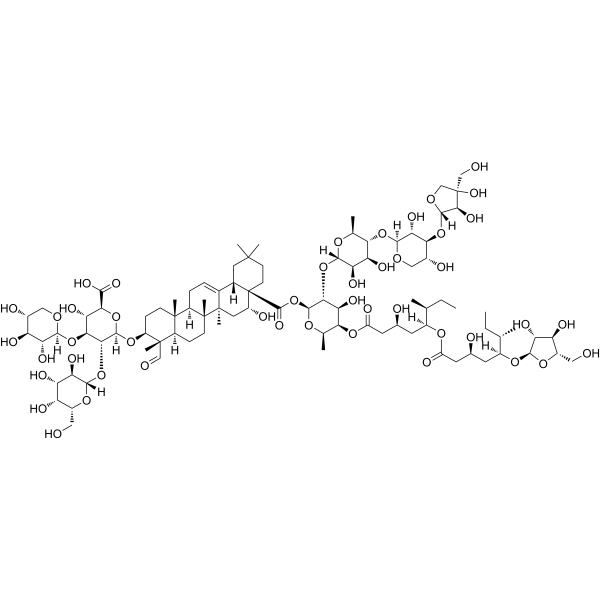| Cas No.: | 141256-04-4 |
| Chemical Name: | QS-21 |
| Synonyms: | QS-21;QS-21 ADJUVANT;b-D-Glucopyranosiduronic acid, (3b,4a,16a)-28-[[O-D-apio-b-D-furanosyl-(1®3)-O-b-D-xylopyranosyl-(1®4)-O-6-deoxy-a-L-mannopyranosyl-(1®2)-4-O-[5-[[5-(a-L-arabinofuranosyloxy)-3-hydroxy-6-methyl-1-oxooctyl]oxy]-3-hydroxy-6-methyl-1-oxooctyl]-6-deoxy-b-D-galactopyranosyl]oxy]-16-hydroxy-23,28-dioxoolean-12-en-3-ylO-b-D-galactopyranosyl-(1®2)-O-[b-D-xylopyranosyl-(1®3)]-;(2S,3S,4S,5R,6R)-6-[[(3S,4S,4aR,6aR,6bS,8R,8aR,12aS,14aR,14bR)-8a-[(2S,3R,4S,5R,6R)-3-[(2S,3R,4S,5R,6S)-5-[(2S,3R,4R,5R)-5-[(2S,3R,4R)-3,4-dihydroxy-4-(hydroxymethyl)tetrahydrofuran-2-yl]oxy-3,4-dihydroxy-tetrahydropyran-2-yl]oxy-3,4-dihydroxy-6-methyl-tetrahydropyran-2-yl]oxy-5-[5-[5-[(2R,3R,4R,5S)-3,4-dihydroxy-5-(hydroxymethyl)tetrahydrofuran-2-yl]oxy-3-hydroxy-6-methyl-octanoyl]oxy-3-hydroxy-6-methyl-octanoyl]oxy-4-h;QA 21;QA 21V1;QS 21;QS-21-Api;Saponin QA 21V1;CL130;β-D-Glucopyranosiduronic acid, (3β,4α,16α)-28-[[O-D-apio-β-D-furanosyl-(1→3)-O-β-D-xylopyranosyl-(1→4)-O-6-deoxy-α-L-mannopyranosyl-(1→2)-4-O-[5-[[5-(α-L-arabinofuranosyloxy)-3-hydroxy-6-methyl-1-oxooctyl]oxy]-3-hydroxy-6-methyl-1-oxooctyl]-6-deoxy-β-D-galactopyranosyl]oxy]-16-hydroxy-23,28-dioxoole... |
| SMILES: | [C@@]12(CCC(C)(C)C[C@]1([H])C1=CCC3[C@@]4(C)CC[C@H](O[C@@H]5O[C@@H]([C@@H](O)[C@H](O[C@H]6OC[C@@H](O)[C@H](O)[C@H]6O)[C@H]5O[C@H]5[C@H](O)[C@H]([C@@H](O)[C@@H](CO)O5)O)C(=O)O)[C@@](C)(C=O)[C@]4([H])CC[C@@]3(C)[C@]1(C)C[C@H]2O)C(=O)O[C@H]1O[C@H]([C@@H](O)[C@@H](OC(=O)CC(O)CC(C(C)CC)OC(=O)CC(O)CC(C(C)CC)O[C@H]2[C@H](O)[C@@H](O)[C@H](CO)O2)[C@@H]1O[C@@H]1O[C@H]([C@H](O[C@H]2OC[C@@H](O)[C@H](O[C@H]3OC[C@](O)(CO)[C@H]3O)[C@H]2O)[C@@H](O)[C@H]1O)C)C |
| Formula: | C92H148O46 |
| M.Wt: | 1990.13195514679 |
| Purity: | >98%, Standard References Grade |
| Sotrage: | 4°C for 1 year, -20°C for more than 2 years |
| Description: | QS-21, an immunostimulatory saponin, could be used as a potent vaccine adjuvant. QS-21 stimulates Th2 humoral and Th1 cell-mediated immune responses through action on antigen presenting cells (APCs) and T cells. QS-21 can activate the NLRP3 inflammasome with subsequent release of caspase-1 dependent cytokines, IL-1β and IL-18[1][2][3]. |
| Target: | NLRP3 inflammasome |
| In Vivo: | Studies in mouse APCs (DCs and macrophages) identifie QS-21 as an activator of the NLRP3 inflammasome, and cause subsequent release of caspase-1 dependent proinflammatory cytokines I1-1β/I1-18 that can promote Th 17 cell maturation or drive INF-γ-mediated Th1 responses, respectively[3]. |
| References: | [1]. Fernández-Tejada A, et al. Development of Improved Vaccine Adjuvants Based on the Saponin Natural Product QS-21 through Chemical Synthesis. Acc Chem Res. 2016;49(9):1741-1756. [2]. Marty-Roix R, et al. Identification of QS-21 as an Inflammasome-activating Molecular Component of Saponin Adjuvants. J Biol Chem. 2016;291(3):1123-1136 [3]. Lacaille-Dubois MA. Updated insights into the mechanism of action and clinical profile of the immunoadjuvant QS-21: A review. Phytomedicine. 2019;60:152905. |






















